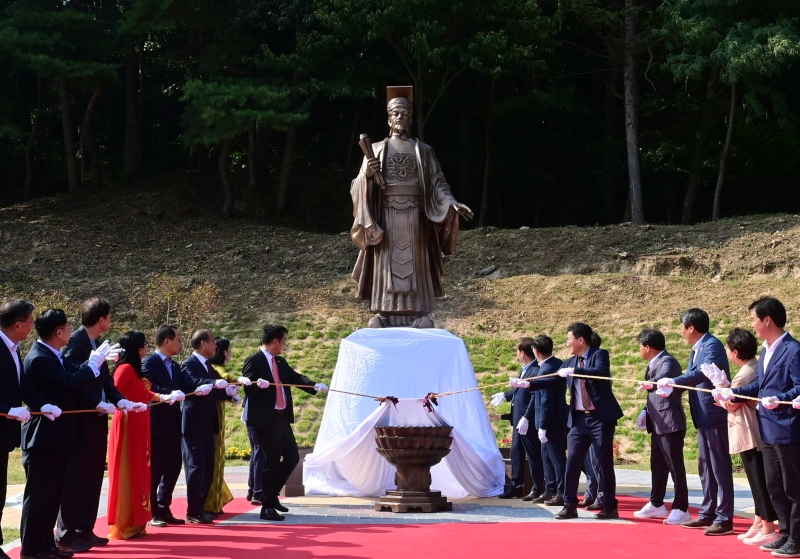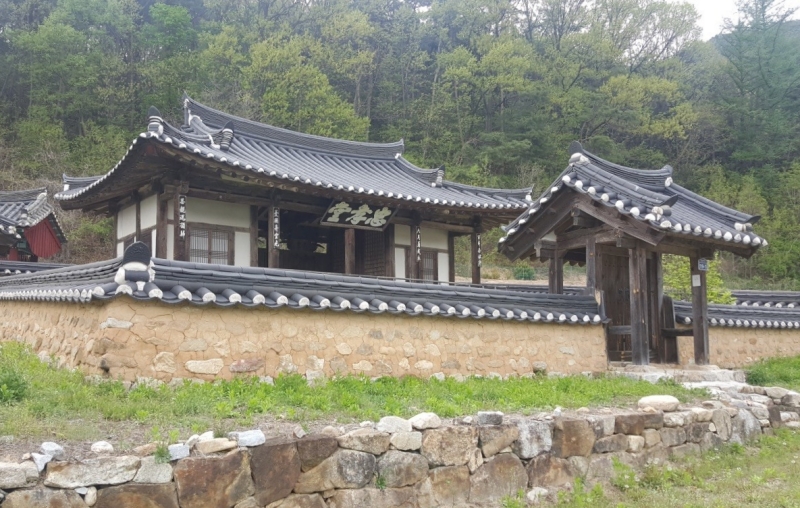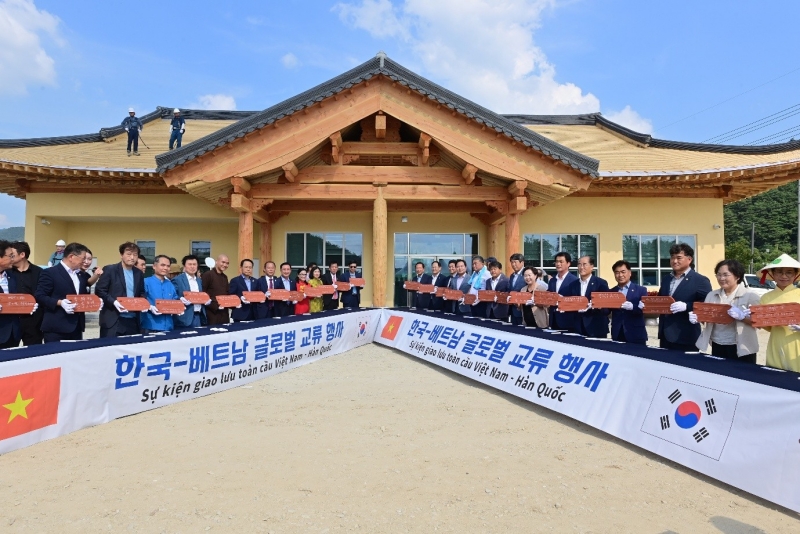- 한국어
- English
- 日本語
- 中文
- العربية
- Español
- Français
- Deutsch
- Pусский
- Tiếng Việt
- Indonesian

The Korea-Vietnam Global Exchange Festival was held on Aug. 24 at Chunghyodang Shrine in the township of Bongseong-myeon in Bonghwa-gun County, Gyeongsangbuk-do Province. Shown is the unveiling of a statue that day of Vietnamese King Ly Thai To (974-1028), the founder of the Ly Dynasty that unified the Southeast Asian country under a centralized state. (Bonghwa-gun Office)
By Park Hye Ri
The unveiling of a statue of King Ly Thai To (974-1028), founder of the Ly Dynasty that unified Vietnam in 1009 under a centralized state, on Aug. 24 was unveiled for the first time at the Korea-Vietnam Global Exchange Festival.
Held at Chunghyodang Shrine in the township of Bongseong-myeon in Bonghwa-gun County, Gyeongsangbuk-do Province, the event reaffirmed the longstanding ties between the small county and the dynasty.
The connection between Bonghwa-gun and the dynasty dates back to the 13th century, when Vietnam's Tran Dynasty in 1226 seized power in 1226 and forced the prince Ly Long Tuong, a sixth-generation descendant of Ly Thai To, into exile. He fled first to Southern Song of China and made his way through Taiwan and Jin China and Mongolia before reaching the Goryeo Kingdom of the Korean Peninsula, specifically Hwasanpo in Ongjin-gun County, Hwanghaenam-do Province in present-day North Korea.
The Goryeo court at the time warmly welcomed the Vietnamese prince, conferring him the surname Yi (Lee) from the Hwasan clan and helping him settle. The prince adopted the Korean name Yi Yong-sang.
His second son Yi Il-cheong was later appointed magistrate of Andong, and his descendants formed a clan village in Andong and Bonghwa-gun.
This history of migration explains why Bonghwa-gun is the only place in Korea with traces of the Ly Dynasty's descendants. A prime example is Chunghyodang Shrine, which honors the loyalty and filial piety of Yi Jang-bal (1574-92), the 13th-generation descendant of the Hwasan Yi clan who died in the Battle of Mungyeong during the Imjin Waeran, or the Japanese invasions of the Korean Peninsula in the late 16th century.
A memorial stone, his tomb and a ritual hall remain to honor Yi.

Chunghyodang Shrine is located in the village of Changpyeong-ri in the township of Bongseong-myeon in Bonghwa-gun County, Gyeongsangbuk-do Province. The facility was built to honor the loyalty and filial piety of Yi Jang-bal (1574-92), the 13th-generation descendant of Yi Yong-sang who was killed in action while fighting Japanese invaders in Korea in the Imjin Waeran, or Japanese invasions of the Korean Peninsula in the late 16th century.
Bonghwa-gun is pursuing a project to set up K-Vietnam Valley, the country's lone project to set up a Vietnamese town, to modernize the county's 1,000 years of ties with Vietnam. About KRW 200 billion through 2033 will be invested to create the valley on 118,890 square m in the village of Changpyeong-ri in the township of Bongseong-myeon.
The venture also aims to promote bilateral friendship, overcome the crisis of regional extinction and attract tourists.
The valley has four themed areas. Its historical district will include the shrine's ruins, statue of Vietnamese monarch Ly Thai To, Vietnamese history museum and Buddhist temple. The cultural and educational section will house a Korea-Vietnam history and culture center and an international school for children from multicultural families.
The resort zone will have an interactive rice paddy center and guest house, and the "Exchange Road" area will house an observatory and pedestrian bridge. Thus visitors can experience the history and culture of both Korea and Vietnam.
Construction of multicultural community center, a catalyst of the valley project, is scheduled for completion on Sept. 12. The venue will also be used for meetings of multicultural residents including Vietnamese.
Bonghwa-gun Mayor Park Hyeon-guk on Aug. 10 met Vietnam's top leader To Lam, general secretary of his country's Communist Party who recently visited Korea, to brief him on the Vietnamese prince Yi Yong-sang and the valley project.
General Secretary To expressed gratitude for Korea's interest in both Vietnam and its people and said he hoped for continued development of bilateral relations.

Participants of the roof-erecting ceremony for the multicultural community center of K-Vietnam Valley on Aug. 24 take a group photo at the township of Bongseong-myeon in Bonghwa-gun County, Gyeongsangbuk-do Province. (Bonghwa-gun Office)
In May, the valley venture was selected as one of the Ministry of Culture, Sports and Tourism's development projects for regional tourism. Bonghwa-gun said it will maximize synergy by building the Vietnamese-themed village "The Vongtnam (Complex Space)" and K-Hoan Kiem Lake and host the Xin Chao (Hello) Vietnam Festival featuring silver carp and pine mushrooms.
hrhr@korea.kr